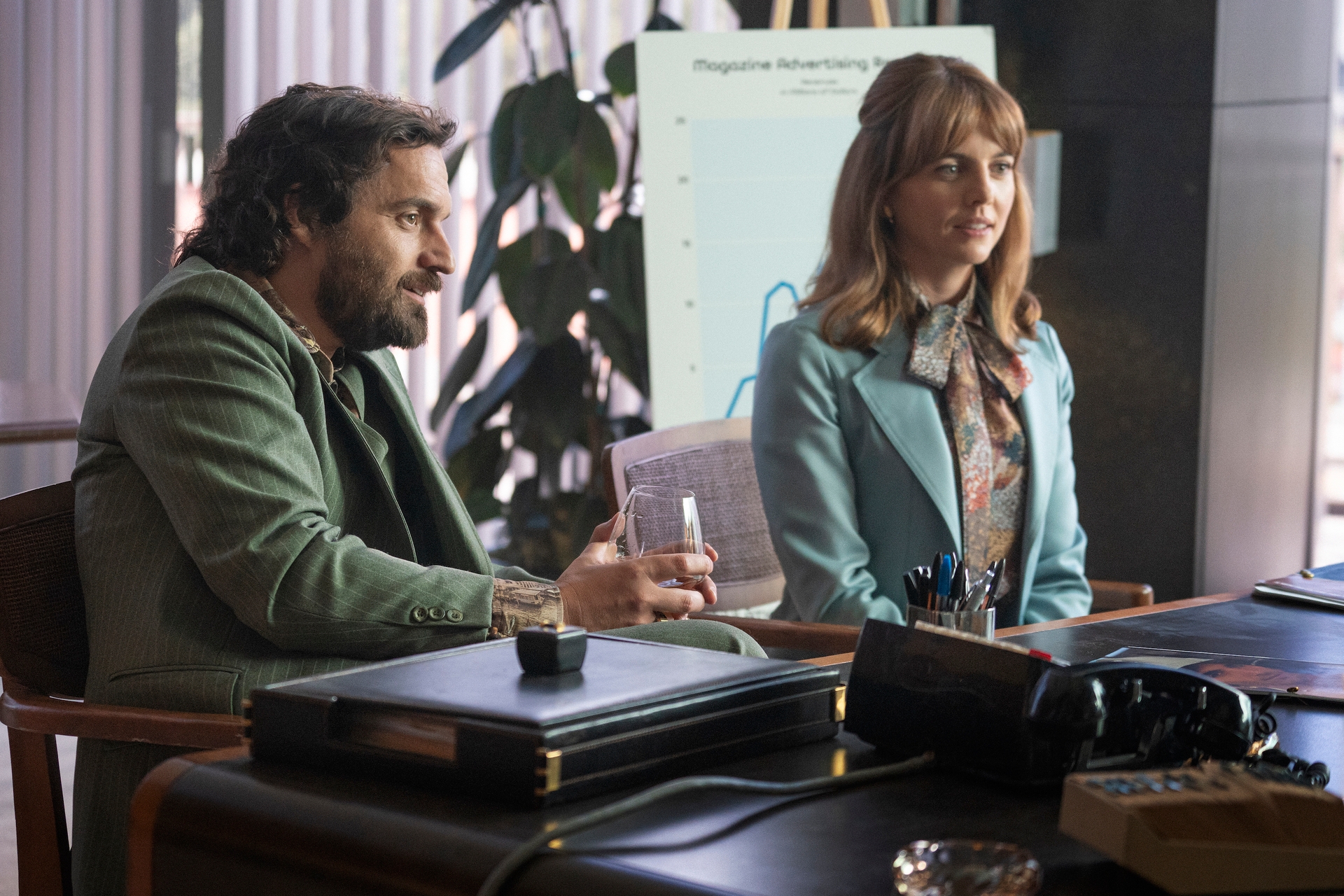Minx offers a fun, ’70s-set look at evolving sexual mores
Jake Johnson was apparently born to play a charming, polyester-clad porn publisher in the new HBO Max comedy
TV Reviews Minx
There’s a long string of workplace TV shows featuring the plucky upstart guided by a world-wearier mentor. Just think of Mary Richards and “I hate spunk” Lou Grant of The Mary Tyler Moore Show. More recently, we’ve seen Peggy Olsen rise through the ranks aided by Don Draper in Mad Men, and Ruth Wilder try to craft actual art out of the 1980s GLOW lineup, under the frustrated/amused tutelage of manager Sam Silvia.
Minx brings GLOW to mind, although it’s a period piece set in a different decade: the full-on polyester-laden ’70s, where this particular plucky young upstart Joyce (Ophelia Lovibond) is determined to bring her feminist manifesto of a magazine, The Matriarchy Awakens, to fruition. Unfortunately for Joyce, the earnestness of her Vassar-educated self has pushed her into a completely tone-deaf territory, so ambitious and humorless that she doesn’t seem to be having any fun at all as she attempts to live out her childhood dream.
Fortunately for Joyce, and the series, she runs into Doug (Jake Johnson), a porn magazine publisher intrigued by her lofty ideas (and ideals) who offers to publish her magazine with some major tweaks. The Matriarchy Awakens is quickly renamed Minx, and after the skyrocketing success of Burt Reynolds on a bearskin rug in Cosmo, will feature a monthly nude male centerfold. Minx’s casting calls for those centerfold models display more full frontal male nudity in a few moments than any other show has accomplished in a lifetime.
Minx’s main draw is its depiction of a very specific period in American culture (that Cosmo centerfold dates it at 1972) as the women’s lib movement tried to take hold. Joyce, with her pedantic lecturing and lofty intellectualism, has no idea how to reach the women she’s purportedly trying to help. But the rest of the Minx crowd do: like former cover girl Bambi (Jessica Lowe), Doug’s right hand and possibly more Tina (Idara Victor), creative photographer and designer Richie (Oscar Montoya), and even Joyce’s own sister (Lennon Parham, making the most of an enjoyable supporting role), who fits in with the Minx staff much better than Joyce does. There’s a ton of fun to be had when the Minx crew invades Joyce’s family’s tennis club, for example, their platform shoes and glinty gold jewelry making them immediately stand out from the country-club set.
If Minx has a sore spot at all, it’s the main character who’s supposed to be our focus. Joyce may have been working on this magazine in her bedroom since the seventh grade, but that doesn’t give her any of the work or life experience that the other staff has—especially Doug, who she stymies at every turn, protesting when the first Minx photo shoot isn’t making the proper statement. “What I’m trying to do is real, and it’s hard, and there are no shortcuts,” she tells the man who has a dozen titles under his oversized belt buckle already.
She’s downright rude to the staff members (and sibling) who are trying to help her, frustrated when they’re not quite as enthusiastic about her “Out For Blood: A Fight For Menstrual Reckoning” article as she is. Bambi, Richie, et al., get that the questions at their centerfold’s first press conference are much more likely to be along the lines of “What are your turn-ons?” than Joyce’s suggestion of “As the Soviet Union and collectivist East turn toward radical egalitarianism, what role do Western democracies have in abolishing gender distinctions?”
But judging from her co-stars’ frequent eyerolls, Minx is well-aware of Joyce’s over-the-top earnestness. And fortunately, her grating ways are balanced out by a masterful performance from Johnson, who was clearly born in the wrong era and should only be wearing clothes made from synthetic fibers. Doug is enthusiastic about the possibilities tied to Joyce’s magazine, but is also quick to cut her off when he’s reached his limit. (“Grow the fuck up!” he admonishes at one point.)
In his own way, Doug is as ambitious as Joyce, anxious to reach a respectable level in his publishing career where the ads in his magazines advertise fewer dildos and more pantyhose. Unlike her, he’s aware of the realities of these industries he’s in, where keeping his enterprise alive may mean glad-handing some politicians, or engineering a mob-fueled distribution system.
Johnson, so underutilized since New Girl, commandeers a part like Doug, an unforgettable character capable of charming every woman he comes across, down to a city councilperson’s office staff, while showing a deep masculine sensitivity that’s unusual for the time period but just makes him all the more endearing. And Doug’s jovial response after Joyce corrects his pronunciation of Proust—“Do most people enjoy your company?”—is nothing if not stellar.
The most exciting parts of Minx—that is, apart from the spot-on attention to 1972 detail in graphic design, cars, and especially wardrobe—involve seeing these two characters progress together (although hopefully not in a will-they/won’t-they manner; Doug and Tina are perfect for each other, and she’s the real brains of that partnership). Inspired by Joyce’s activism, Doug doesn’t chime in on the racist banter of the mob guys at a party—which ultimately winds up working to his advantage. At the same gathering, Joyce observes how the mob wives utilize more traditional domestic structures to get what they want; in their own way, they’re just as in charge as Joyce is at Minx.
It’s the dawn of a new era, and times are definitely changing. Minx is a fun examination of not only evolving sexual politics but the myriad emotions behind them.